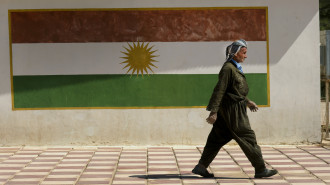Mosul: A wounded city trying to heal
"I haven't been here in more than a year," he admitted. "I can't stand the vision of the ruins. The smell of death and most of the rubble are gone, but the sight of destruction of our city is hard to bear for me".
On a Friday afternoon, the streets of the Old City are almost empty. A few passers-by emerge only to quickly disappear at the corner of an alley. There are more policemen on the crossroads than cars.
Rubble and destruction
We arrive at an open space where apartment blocks once stood, the entire area turned to dust by airstrikes. On the other side, a statue was erected last year. It represents a man putting rubble into a wheelbarrow.
"It's a monument to celebrate those who cleaned up the city after the war. Cleaning up after IS was a very dangerous activity," Mohammed explained. "The Islamic State left thousands of booby traps all over the city, in the most Machiavellian places, sometimes under toys or dead bodies. I believe more people died and are still dying from booby traps than from the actual fighting".
As we keep walking, children playing in the rubble stop to greet us, intrigued at the sight of our cameras. They pause for a picture and giggle while staring at the result, oblivious for a minute to the vision of desolation around them. Further up the street lie the remains of the Great Mosque of Al-Nuri.
The sanctuary is now completely fenced-up by a UNESCO mission engaged in a reconstruction process following the war. The last remnants of al hadbah (the hunchback), the legendary tilted minaret of the mosque, are carefully wrapped in tarp. It is uncertain whether it will be restored to its former emblematic glory.
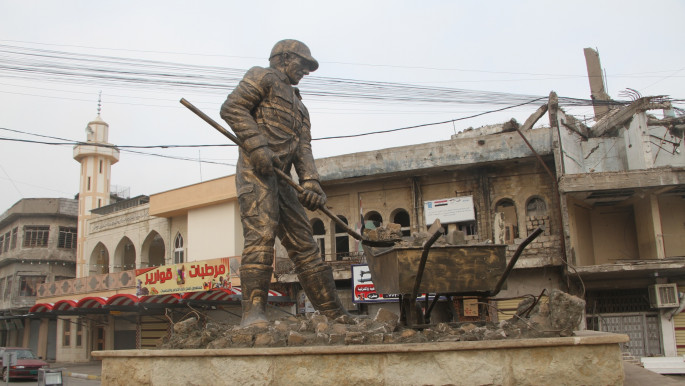 |
|
| A statue honouring those who helped rebuild Mosul. [TNA/Sylvain Mercadier] |
UNESCO has erected large billboards to publicise its renovation project, even launching an international architectural competition last November for conceptual designs to rebuild the 12th century mosque. But most people who spoke to The New Arab were unaware, or sometimes even critical, that so much importance was being given to a mosque while the city's infrastructure lies in tatters three years after the end of the battle to recapture the city from IS.
Early in 2018, Kuwait hosted an international conference that aimed to raise $100 billion to rebuild Iraqi cities, but it fell short by two thirds. No one, it seemed, was interested in helping Mosul turn the page of destruction.
 |
There is no more government here. No salaries, no services. I lost two members of my family, my house, everything. We're on our own now |  |
"There is no more government here. No salaries, no services," listed Marwan Taher Youssef on his fingers. A local resident of West Mosul, he spoke to us in the middle of a roundabout next to policemen. "I lost two members of my family, my house, everything. We're on our own now".
After descending the almost empty Farouq street, we pass a battle-damaged Latin church, built by Dominican priests in the late 19th century. Although seriously damaged by fighting at the gate of the Old City, the church still proudly stands. Nonetheless, behind the high walls massive damage is still noticeable. The same can be said of most housing blocks.
Beyond the main streets, which have been cleared of rubble, scenes of destruction and chaos are commonplace. Old houses remain ripped open since they were bombed by international coalition airplanes or drones. Many families have returned to, or even stayed in, these insalubrious homes due to the lack of alternative options.
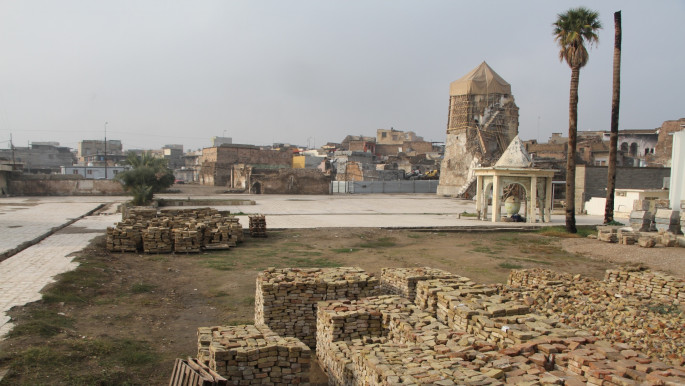 |
|
| The sanctuary of Al-Nuri mosque under renovation. [TNA/Sylvain Mercadier] |
The Mukhtar's tour
In a courtyard stand two swings, but the chains are tied together as if to prevent children from enjoying them. Two local residents greet us there. One is Abu Fahed, the Mukhtar of the area. He has the responsibility of hearing complaints from neighbourhood residents and following up with local authorities and security forces.
Abu Fahed is symbolic of Mosul's rich but sad history. No one seems prouder than him of the city's heritage as he dwelled on Mosul's diversity. "This neighbourhood was Jewish, you know?" he said, as we walked through empty covered alleys. "These arcades sheltered Jewish shops, mostly craftsmen, jewellers. This was actually a mixed neighbourhood. Let me show you what is left of the Muslim heritage in this part", he added, before leading the way.
 |
This mosque is a symbol of Mosul's openness to the world. But these terrorists destroyed everything they considered idolatry. It's a shame |  |
"Here lived the Khadouris, here the Rothschild's grandfather had a house," he explained, pointing out historical anecdotes in the empty alleys of the Kalakshi neighbourhood. Turning a corner, he then opened the lock of a large iron gate. "This is al Ruba'iya mosque. Look at the carvings. Daesh destroyed it all with chisels. They considered these unorthodox although it's a Sunni mosque."
Inside, the destruction is disturbing. Coalition planes bombed the houses adjacent to the mosque, which damaged the 18th century building. A majestic dome lies in ruins next to a destroyed courtyard. The buildings on the side are a pile of rubble. The mosque's chandelier lies in the middle of the square alongside dirt, trash and piles of stones.
Inside the mosque, which was partially cleaned, IS propaganda leaflets are still present. "This mosque is older than the Great Mosque of Al-Nuri, but it was rebuilt in 1776 AD," says Abu Fahed. "Look at the stones of the dome, they are Karbala stones. This mosque is a symbol of Mosul's openness to the world. But these terrorists destroyed everything they considered idolatry. It's a shame".
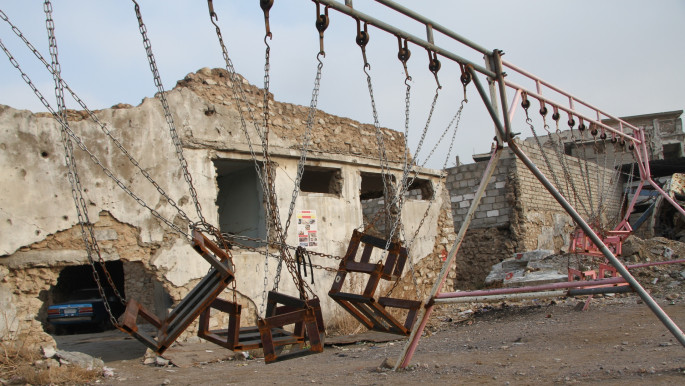 |
|
| A locked-up swing in West Mosul. [TNA/Sylvain Mercadier] |
The contrast of East Mosul
Afterwards we headed to the eastern part of Mosul. The contrast is staggering, almost as if we were in a different city. The eastern side of the Tigris suffered far less destruction, allowing its inhabitants to keep up a relatively normal life. The streets are busier, the shops have more to offer, and the city's infrastructure has been maintained. In Souq al-Nabi Yunis, the largest market in town, hundreds of shops are fully stocked with products.
East Mosul was able to adapt quickly and even profited from the displacement of thousands of western Mosul inhabitants. Even so, beyond the relative prosperity, poverty remains. Beggars are a common sight and children offer plastic bags to passers-by to make a few dinars to support their families.
Decades before Mosul's destruction, a massive rural exodus had brought tens of thousands of villagers to the vibrant city seeking a better life. For most of them, Mosul became a place where they ended up living in misery. They had no access to education and were marginalised by a city which did not know what to do with them. Then came the extremists.
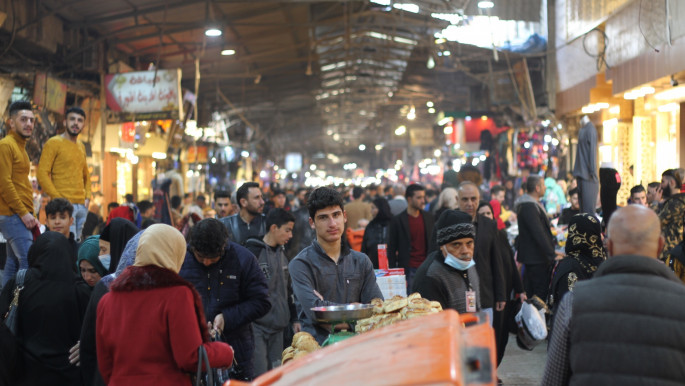 |
|
| Souq al-Nabi Yunis in East Mosul. [TNA/Sylvain Mercadier] |
IS took advantage of the despair and disorientation that befell the impoverished Sunni community following decades of war, sanctions and the dismantling of state institutions. "Many Sunnis saw in Daesh a way to revive the strength of their community, but they were mistaken. They thought it would revive the feeling of empowerment they had in the times of Saddam, but they were wrong, and our city is here to prove it," Mohammed Salama told The New Arab.
Like the rest of his family, he moved from West to East Mosul to a comfortable house. "Our mansion in the West was bigger, but it was damaged and there's no more water, electricity, no nothing. Thank God no one in our family died. We are one of the very few who can say that," he confessed.
What is to become of Mosul and its inhabitants? That all depends on their representatives. For most, corruption remains a major concern, with many openly deriding the political elites that run the country as 'thieves'.
For Mohammed, like most young men in Iraq, the dream is to move abroad. He wants to travel to Italy and finish his studies in literature. "My favourite book is Dante's Inferno, from the Divine Comedy," he said, staring pensively. "I've come to appreciate it greatly with time".
Sylvain Mercadier is a freelance journalist. Follow him on Twitter: @Sylv_Mercadier




 Follow the Middle East's top stories in English at The New Arab on Google News
Follow the Middle East's top stories in English at The New Arab on Google News


